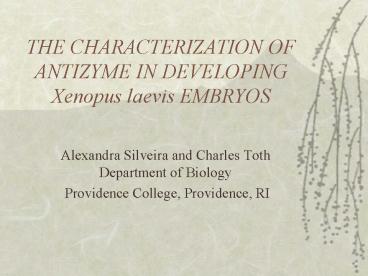THE CHARACTERIZATION OF ANTIZYME IN DEVELOPING Xenopus laevis EMBRYOS PowerPoint PPT Presentation
1 / 27
Title: THE CHARACTERIZATION OF ANTIZYME IN DEVELOPING Xenopus laevis EMBRYOS
1
THE CHARACTERIZATION OF ANTIZYME IN DEVELOPING
Xenopus laevis EMBRYOS
- Alexandra Silveira and Charles Toth Department of
Biology - Providence College, Providence, RI
2
Protein Degradation
- Cell cycle and proliferation
- Differentiation and development
- Stress response
- Genesis of neural networks
- Modulation of cell surface receptors
- Regulation of immune response
- Apoptosis
- Transcriptional regulation
- Pathogenesis
- Cancer, cystic fibrosis, neurodegenerative
diseases
Charles Toth, Providence College
3
Protein degradation by the 26S proteasome
http//www.rpi.edu/dept/bcbp/molbiochem/MBWeb/mb2/
part1/protease.htm
4
Protein degradation by the 26S proteasome
5
ODC degradation a unique protein degradation
pathway
John Mitchell, University of Northern Iowa
John Mitchell, University of Northern Iowa
6
ODC and Polyamine Biosynthesis
http//www.bios.niu.edu/mitchellab/general.html
7
Polyamines
- Organic compounds found bound to RNA and DNA in
cells - High levels are toxic
- Necessary for cell growth and survival
- gate currents of ion channels
- have effects on chromatin condensation and
transcriptional regulation - neutralize negative charges of RNA and DNA
- regulate the levels of AZ
- provide a necessary postranslational modification
to eIF-5a protein
http//www.biol.lu.se/zoofysiol/Cellprolif/Researc
h/research_area_1.html
8
AZ Functions
- ODC degradation
- Anti-proliferative effect on cells
- Blocks uptake of additional polyamines when
polyamine levels are too high - High levels of polyamines in turn regulate AZ
through a ribosomal frameshift
http//www.bios.niu.edu/mitchellab/general.html
9
Ribosomal Frame-Shifting
- High levels of polyamines cause a ribosomal frame
shift that produces an active form of AZ. - Without the ribosomal shift a truncated and
inactive AZ is formed.
10
Why study antizyme?
- Studying the unique ODC degradation pathway can
lead to a better understanding of - ubiquitin mediated protein degradation
- the many roles of polyamines in the cell
- AZ is a member of an ancient gene family
- AZ1 and AZ2 widely expressed and involved in ODC
degradation - AZ3 is testis specific
11
Why study antizyme?
- AZ has been cloned from various organisms
- vertebrate-man, chicken, rat, mouse, zebrafish,
Xenopus, electric ray - invertebrate-Drosophila, S. pombe, C. elegans,
silk worms, gray mold, etc. - AZ knockout in mice (Matsufuji Noda)
- viable and morphologically normal
- high rate of prenatal fatality from high levels
of ODC - phenotype complicated by additional family
members
12
Xenopus As A Developmental Model
- Ideal model because
- easily cared for in lab
- in vitro fertilization
- the developing embryos are easily cared for
- the embryos develop quickly
http//www.xenopus.com/products.htm
13
Xenopus life cycle
Wolpert et al., Development 2000
14
Methods
- In vitro fertilization
- Northern Blot
- Immunohistochemical Staining
15
In Vitro Fertilization
- Female frogs are injected with HCG to induce
ovulation - Male frogs are sacrificed in order to obtain
internal testicles - Eggs are fertilized in vitro
http//www.fundamentalbiology.arc.nasa.gov/Image1.
jpg
16
Northern blot analysis
www.columbia.edu/.../c2005/handouts/
northernforweb.gif
17
Northern blot results
- AZ is expressed as a maternal and zygotic
transcript - Size of message increases post-MBT
- MBT is the point where zygotic genes are
expressed instead of maternal genes and the cell
cycle becomes asynchronous indicating the
beginning of differentiation
Charles Toth, Providence College
18
Conclusions
- Different sizes of antizyme mRNA are present
during different times in embryonic development. - A larger mRNA message is present post-MBT.
19
Possible Implications
- The larger messages can indicate a
- a closely related familial gene
- different post-transcriptional modifications that
ensure zygotic gene expression - Results are inconclusive because of the ribosomal
frame-shift needed to produce an active form of
AZ.
20
Immunohistochemical Staining
- Antibodies against antizyme are used to
detect and stain antizyme in the developing
embryo.
http//www-celanphy.sci.kun.nl/Bruce20web/Bruce2
0Gifs/immunocyto.gif
21
Immunohistochemical Staining Results
- Stage 10 embryos
- There is a darkly staining ring around the
blastopore from which the mesoderm will develop. - The animal cap is almost uniformly stained.
22
Immunohistochemical Staining Results
- Stage 18/19
- Top image
- staining along the neural groove and at both the
anterior and posterior ends of the embryo, some
staining at the ventral side - Bottom image
- dorsal side shows dark staining at the posterior
and anterior ends and a ring pattern of staining
in the area that will eventually give rise to the
mesoderm
23
Immunohistochemical Staining Results
- Stage 33/34
- Staining is primarily focused around the somites
and the anterior end of the tadpole - These locations are where the muscles and nerves
are developing
24
Conclusions
- There is clearly a differential expression of
antizyme during the various stages of embryonic
development. - staining of ring around the blastopore and animal
cap - staining of the neural groove, anterior and
posterior ends, ventral, and dorsal lateral
staining - staining of the somites and anterior portion of
the tadpole
25
Possible Implications
- The staining around the blastopore ring, the
dorsal-lateral staining of the neurula, and the
somite staining of the tadpole implicate a role
of antizyme in muscle development. - The staining of the animal cap and the anterior
end of the developing embryo implicate a role of
antizyme in the development of the central
nervous system.
26
Future Endeavors
- In situ
- Western
- ablation studies
- forced expression
27
Acknowledgements
- Dr. Charles Toth
- Dr. Senya Matsufuji
- Jikei University, Tokyo
- Tiffany LaFortune
- My family
- My roommates

